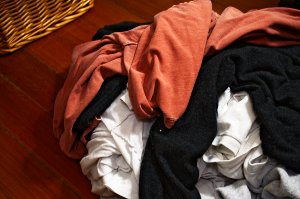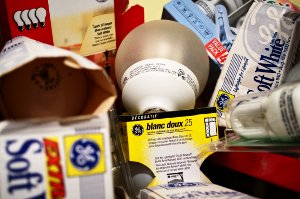 Shockingly enough, I absolutely love the scene in “Mary Poppins” when Jane and Michael Banks snap their fingers to tidy up the nursery. Crooked wall hangings are immediately straightened, toys magically place themselves in cabinets, and beds are made in the blink of an eye.
Shockingly enough, I absolutely love the scene in “Mary Poppins” when Jane and Michael Banks snap their fingers to tidy up the nursery. Crooked wall hangings are immediately straightened, toys magically place themselves in cabinets, and beds are made in the blink of an eye.
Joyful singing and finger snapping aside, tidying your home is a very simple task if you follow one or all of these three basic guidelines.
1. Put things back where they belong. Always.
This may seem obvious, but it’s amazing how many times a day we do the exact opposite. This week, challenge yourself to put everything back where it belongs after you use it. Everything! Your keys, the mixing bowl, the cordless telephone, your coat, your gloves (yes, both of them), the milk carton, etc. If you don’t already do this, expect to see a dramatic shift in the tidiness of your home. If you already do this, thank you for warming my heart.
I’ve done my own unscientific study of this concept, and I’m pleased to unveil the results: when the hubster and I curl up on the couch to read or watch television, we enjoy using a beautiful handmade afghan that was a wedding gift from a dear friend. Afterward, we have two options: we can fold the afghan and place it on the arm of the couch (its appointed spot when not in use) or we can leave it in a heap on the couch for later use.
Technically speaking, the afghan is not affected either way. It doesn’t get wrinkled or offended when we neglect it. But my key findings indicate that the house looks a lot tidier when we take that extra moment to fold the afghan and put it back where it belongs. Now multiply that by the tidiness that prevails when you hang your coat in the closet instead of on the back of a chair, or when you hang up your towel instead of tossing it on the floor, or when you put your keys wherever they belong instead of in the middle of the kitchen counter.
 2. Piles should never rule the roost. Ever.
2. Piles should never rule the roost. Ever.
I have yet to be in a home that has no piles. The hubster and I certainly have them and it’s likely that you do, too. They might be small. Some are large. You might have one. You might have twenty. And not all piles are equal. Some contain just photos or just bills or just clean laundry or just light bulbs. Others contain a combination of items including everything from magazines to children’s art projects to credit card offers to ticket stubs to expired coupons.
And that’s the main problem with piles. We put things in piles in an effort to be organized, only to find that we don’t always remember what we put in the piles in the first place – and that defeats the whole purpose. Try some or all of the following tips to ensure that your piles work well for you.
When handled with care, piles can be quite useful.
Take a look around your house and determine what you put in your piles. Are they organized by like items or are they catch-all “filing systems?”
Next, take some time to go through your piles and sort like things together in an entirely new pile configuration (i.e. bills in one pile, art projects in another, ticket stubs in a third pile, and magazines in a fourth pile).
Tip: Focus on all of the piles in the kitchen before you tackle the ones hanging out on your desk. Going through your piles room-by-room will make things manageable from the get-go.
Take each newly organized pile and identify where its contents really belong (I guarantee you that the answer is probably not “in a pile on the kitchen counter”).
- Bills and other paperwork should be stored in files.
- Art projects are most easily enjoyed when hanging on walls, bulletin boards, or the refrigerator. Of course, they can also be stored in a keepsake box or recycled after a thoughtful conversation with the artist (depending on the art and your philosophy about keeping every piece of childhood artwork ever created).
- Ticket stubs are meant for one of two places: your scrapbook or the recycle bin.
- Magazines can be placed in a basket near a reading nook, on a bookshelf, or in your nearest recycling bin.
- Your remaining piles should be organized by like items and used for things that need action within the next week, such as: bills you have not yet paid, field trip permission slips awaiting your autograph, and dry cleaning stubs for shirts awaiting pick-up.
- Your laundry piles will cease to exist if you try to fold clothing items and put them away shortly after they come out of the dryer.
For the next month or so, encourage yourself to maintain the new pile and “putting away” system you’ve just established. If something isn’t working for you, change things up a bit to reflect the needs of your household.
3. Appearances aren’t everything, but…
- After using a bathroom towel don’t just toss it on the counter (or – gasp – the floor). When you’re finished with the kitchen dish rag, don’t just leave it in the sink. Instead, place these cloths on racks so that they hang straight down. They’ll dry more quickly and look tidier, too.
- After the dishes and utensils in your counter drying rack are moisture-free, put them in their cabinets and drawers. This is a simple way to remove unnecessary clutter in your kitchen.
- If you enjoy some cocoa tonight before bedtime, wash your mug or put it in the dishwasher before you head to sleep. When done on a daily basis, washing dishes is not overly time consuming. Plus, it’s a lot easier to clean dishes when food bits have not cemented themselves to your plates.
- Make your bed. I know I’m not your mother, but she was right about this one. Tangled sheets mingled with pillows strewn everywhere tend to make things look messy and uninviting. Just think of how relaxing it is to walk into a spic and span hotel room with a bed that has been made up just for you. The same ambiance can be yours at home – and it’s just a smooth folded sheet and comforter away.
And as Mary Poppins says, “In every job that must be done, there is an element of fun. You find the fun, and – snap – the job’s a game!” So go put on some fun dance music and enjoy tidying up. Snapping your fingers and singing is optional.
* Photos by Jonathan Eggers




I’ve been thinking about ways to tackle the clutter and clear the decks. This is very helpful, practical advice. Thanks, Leah!